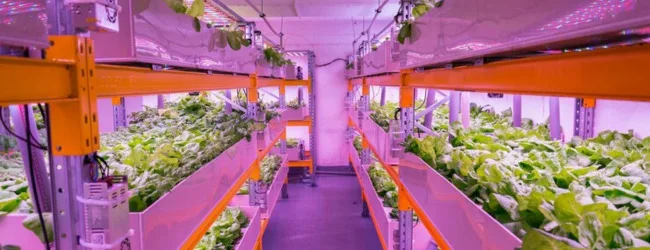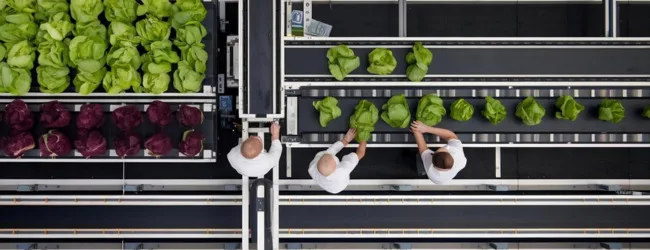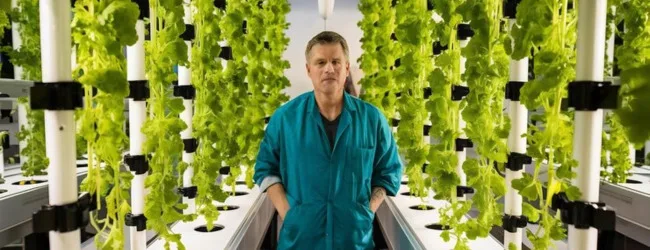Table of contents
India, a land steeped in agricultural tradition, is increasingly looking towards innovative solutions to meet the growing demands of its burgeoning population while addressing the challenges of limited land, water scarcity, and climate change. Vertical farming has emerged as a promising agricultural technique with the potential to revolutionize food production in the country. This blog post delves into the intricacies of vertical farming in India, exploring its definition, various types, advantages, disadvantages, key takeaways, and its overall impact on the future of Indian agriculture.
What is Vertical Farming?

Vertical farming is an innovative agricultural practice that involves growing crops in vertically stacked layers or inclined surfaces. Instead of traditional horizontal farming on a single level, vertical farms optimize space by utilizing multiple levels within a controlled environment. This method often incorporates soilless farming techniques such as hydroponics, aquaponics, and aeroponics, allowing for precise control over environmental factors like light, temperature, humidity, and nutrients. By maximizing space utilization and creating ideal growing conditions year-round, vertical farming offers a significant departure from conventional agricultural practices.
Types of Vertical Farming

Several distinct approaches fall under the umbrella of vertical farming, each with its unique characteristics and applications:
- Hydroponics: This soilless farming technique involves growing plants in nutrient-rich water solutions without soil. The plant roots are submerged in or exposed to the nutrient solution, providing them with the necessary elements for growth. Hydroponic systems can be further categorized into various types:
- Deep Water Culture (DWC): Plant roots are suspended in an oxygenated nutrient solution. This is a simple and cost-effective method suitable for leafy greens.
- Nutrient Film Technique (NFT): A shallow stream of nutrient solution flows continuously over the plant roots, providing them with water, nutrients, and oxygen. NFT is well-suited for fast-growing crops like lettuce, herbs, and strawberries.
- Aeroponics: In this advanced technique, plant roots are suspended in the air and periodically sprayed with a nutrient-rich mist. Aeroponics offers excellent oxygenation to the roots, leading to faster growth and reduced water usage. It can be used for a wide range of crops, including leafy greens, fruiting vegetables, and root crops.
- Wick Systems: A passive hydroponic system where a wick draws nutrient solution from a reservoir to the growing medium (which can be inert materials like perlite or coco coir). This is a simple system suitable for small-scale vertical farms.
- Ebb and Flow (Flood and Drain): The growing medium is periodically flooded with nutrient solution and then drained back into the reservoir. This system provides good aeration to the roots and is suitable for various crops.
- Aquaponics: This symbiotic system integrates aquaculture (raising fish) with hydroponics. Fish waste, rich in nutrients, is used as fertilizer for the plants in the hydroponic system. The plants, in turn, filter the water, making it suitable for the fish. Aquaponics creates a closed-loop system that is both sustainable and productive, yielding both plant and fish products. It requires careful balancing of the fish and plant components.
- Aeroponics: As briefly mentioned under hydroponics, aeroponics stands out as a distinct vertical farming method due to its unique approach to nutrient delivery. By suspending roots in the air and delivering nutrients via a fine mist, it maximizes oxygen exposure, leading to efficient nutrient uptake and rapid plant growth. Aeroponic systems can be designed in various vertical configurations, including towers and stacked units.
- Vertical Stacking with Soil-Based Agriculture: While often associated with soilless methods, vertical farming can also incorporate traditional soil-based agriculture in stacked layers. This approach is simpler to implement initially and can be suitable for certain root vegetables or crops that prefer a soil medium. However, it may not offer the same level of resource efficiency and environmental control as soilless methods.
Benefits of Vertical Farming in India

Vertical farming offers a multitude of advantages that make it a compelling solution for India’s agricultural challenges:
- Increased Crop Yields: By optimizing growing conditions and utilizing vertical space, significantly higher yields can be achieved compared to traditional farming on the same land area.
- Reduced Water Consumption: Soilless vertical farming techniques like hydroponics and aeroponics can reduce water usage by up to 90-95% compared to conventional agriculture due to water recirculation and precise delivery. This is crucial in water-stressed regions of India.
- Minimized Land Usage: Vertical farms require significantly less land, making them ideal for urban and peri-urban areas where land is scarce and expensive. This can help bring food production closer to consumers, reducing transportation costs and emissions.
- Year-Round Production: Controlled environments within vertical farms eliminate the dependence on seasonal weather patterns, allowing for continuous crop production throughout the year, ensuring a stable food supply.
- Reduced Pesticide and Herbicide Use: The controlled environment minimizes the risk of pests and diseases, significantly reducing or eliminating the need for harmful pesticides and herbicides, leading to healthier and safer food.
- Improved Food Quality and Nutrition: Vertical farms allow for precise control over nutrient delivery, resulting in crops with enhanced nutritional value and consistent quality.
- Climate Resilience: Vertical farming is less susceptible to the adverse effects of climate change, such as droughts, floods, and extreme temperatures, ensuring more predictable and stable food production.
- Job Creation: The development and operation of vertical farms can create new employment opportunities in urban and rural areas, particularly in technology, engineering, and agricultural management.
- Supply Chain Optimization: Locating vertical farms closer to urban centers can shorten supply chains, reduce post-harvest losses, and ensure fresher produce reaches consumers faster.
💡 Pro Tip: If you want to start farming but have too many doubts, connect with a farming expert from Boss Wallah for guidance – https://bw1.in/1116
Disadvantages of Vertical Farming
Despite its numerous benefits, vertical farming also presents certain challenges:
- High Initial Investment: Setting up a vertical farm requires significant upfront capital for infrastructure, technology, and environmental control systems.
- Energy Consumption: Maintaining controlled environments, especially for lighting and climate control, can lead to high energy consumption, potentially increasing operational costs and environmental impact if not powered by renewable sources.
- Technical Expertise Required: Operating and managing vertical farms effectively requires specialized knowledge in areas like hydroponics, aeroponics, environmental control, and plant physiology.
- Limited Crop Range (Currently): While the range of crops suitable for vertical farming is expanding, it is currently more economically viable for leafy greens, herbs, and some fruiting vegetables. Growing staple crops like rice and wheat vertically at scale remains a challenge.
- Pollination Challenges: For fruiting vegetables grown indoors, artificial pollination methods may be required, which can add to the complexity and cost of operations.
- Potential for System Failure: Reliance on technology means that system failures (e.g., power outages, pump malfunctions) can have significant impacts on crop production.
- Learning Curve for Farmers: Traditional farmers may require significant training and adaptation to adopt vertical farming techniques.
ALSO READ | Potato Farming: Requirements, Conditions, and Techniques
Key Takeaways
- Vertical farming is a space-efficient and resource-optimized agricultural technique with significant potential for India.
- Various soilless methods like hydroponics, aquaponics, and aeroponics, as well as soil-based vertical stacking, are employed in vertical farming.
- The benefits of vertical farming in India include increased yields, reduced water usage, minimized land requirements, year-round production, and reduced pesticide use.
- Challenges include high initial investment, energy consumption, the need for technical expertise, and limitations in the range of economically viable crops.
- Strategic investments, technological advancements, and supportive government policies are crucial for the widespread adoption and success of vertical farming in India.
Need Expert Guidance?
Starting a business can be challenging, but you don’t have to do it alone! At Boss Wallah, our 2,000+ business experts are ready to provide valuable insights and guidance. Whether you need help with marketing, finance, sourcing, or any other area of any business, our business experts are here to help you succeed: https://bw1.in/1116
Confused about Which Business to Start?
Want to start your own business but unsure which one to choose? Explore Boss Wallah, where you’ll find 500+ courses by successful business owners, featuring practical, step-by-step guides on starting and growing various businesses.
Find your perfect business idea today: https://bw1.in/1111
Conclusion
Vertical farming represents a paradigm shift in agricultural practices, offering a sustainable and efficient pathway to enhance food security in India. While challenges related to initial costs and technical expertise exist, the potential benefits in terms of resource conservation, increased yields, and climate resilience are immense. As technology continues to advance and costs potentially decrease, vertical farming is poised to play an increasingly significant role in shaping the future of Indian agriculture, particularly in urban and peri-urban areas, contributing to a more sustainable and food-secure nation.
Frequently Asked Questions (FAQs)
- Is vertical farming suitable for all types of crops in India?
- Currently, vertical farming is most economically viable for leafy greens, herbs, and some fruiting vegetables. Research is ongoing to expand the range of suitable crops, including staple crops.
- What is the initial investment required to set up a vertical farm in India?
- The initial investment can vary significantly depending on the scale, technology used, and location of the vertical farm. It can range from a few lakhs for small-scale setups to several crores for large commercial operations.
- How can the high energy consumption of vertical farms be addressed in India?
- Utilizing renewable energy sources like solar power, optimizing lighting systems (e.g., using LEDs), and implementing energy-efficient climate control technologies can help reduce the energy footprint of vertical farms.
- What kind of government support is available for vertical farming in India?
- The Indian government is increasingly recognizing the potential of vertical farming and may offer subsidies, research grants, and support for pilot projects to encourage its adoption. It’s advisable to check with the Ministry of Agriculture & Farmers Welfare and state agricultural departments for specific schemes.
- Can traditional Indian farmers easily adopt vertical farming techniques?
- While there will be a learning curve, with proper training and support, traditional farmers can adapt to vertical farming. Collaboration between agricultural experts, technology providers, and farmer communities is crucial for successful adoption.
- What is the role of technology in vertical farming?
- Technology plays a vital role in vertical farming, including environmental control systems (temperature, humidity, light), nutrient delivery systems (hydroponics, aeroponics), automation (planting, harvesting), and data analytics for optimizing plant growth and resource utilization.
- Are there any successful vertical farming initiatives currently operating in India?
- Yes, there are a growing number of startups and established companies in India that are successfully implementing vertical farming for various crops, particularly in urban centers.
- How does vertical farming contribute to food safety in India?
- The controlled environment of vertical farms significantly reduces the risk of contamination from soil-borne diseases, pests, and environmental pollutants, leading to safer and healthier produce.


